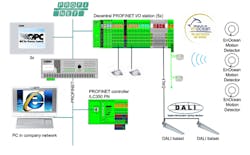Lighting System Reduces Energy and Installation Costs
A lighting system with movement detectors instead of push buttons saves energy. But with the combined Phoenix Contact EnOcean/DALI/PROFINET system, the Belgian electrical wholesaler Breva wanted to demonstrate above all that those contemporary lighting concepts also score well in the field of flexibility and modular design.Breva´s head office moved in April 2008 to a spacious new building. Throughout the building, an innovative lighting concept was installed which consists of three building blocks: wireless modules based on EnOcean technology, gradual operation of the light with digital addressable lighting interface (DALI) elements, and PROFINET as fieldbus between the decentralized I/O islands. DALI is an international standard (IEC 62386) lighting control system providing a single interface for all electronic control gear (light sources) and electronic control devices (lighting controllers). EnOcean is a lighting control wireless standard for building automation. Phoenix Contact is the only supplier able to combine DALI, EnOcean and PROFINET technologies in one solution. Efficient light controlThe office building was first split into five zones. In each of these zones a distribution board with a decentralized PROFINET I/O station was installed. A schematic presentation of the system is shown in the figure. Inputs come from the movement reporters, of which there are about 110 for the whole building. These detect whether there is someone in the room and send a wireless signal to a receiver that is fitted above the false ceiling (see photo). The movement reporters contain an EnOcean radio module, which sends a radio signal over a specific license-free frequency. From the receiver the signal comes into an RS485 module in the decentralized I/O station via a cable. The five decentralized I/O stations are connected by means of a star structure via PROFINET with an Ethernet switch to which a central programmable logic controller (PLC) is also connected via PROFINET (see photo). This PLC, a Phoenix Contact ILC 350 PN, processes the data from the movement reporters and operates the lighting area in question via the same I/O station. The gradual operation of the light fittings occurs by means of DALI. To this end the fittings contain a DALI module, which communicates with the DALI module in the decentralized PROFINET I/O station. The DALI fittings are connected in series to the I/O station by means of a data cable, which reduces the overall cabling needs.Web-based operationIn various rooms the lighting is not operated with movement detectors but by means of control panels. Touch screen panels are linked to the Ethernet data network and exchange data with the PLC via OPC, an open, interoperable connectivity standard. The whole lighting system can also be operated via a Web page that is incorporated in the PLC. The lighting of the entire head office can thus be controlled from any computer that has access to the company network.When asked about the major advantages of the automation solutions, Breva employees don’t have to think long before answering. “The flexibility and modular design are fantastic. You can develop and adapt the system as you wish,” commented one employee. “For example, you can connect the whole system to an electronic agenda or to an Excel file. The system is also modular; it grows with the building and your needs.” Installation of the system is quick and easy as far fewer cables are involved than in a traditional lighting concept. Another advantage is the undeniable energy saving.For more information on PROFINET, visit www.us.profinet.com. For more information on Phoenix Contact solutions, visit www.phoenixcontact.com.

